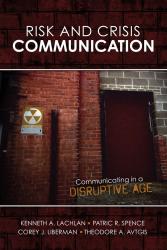Risk & Crisis Communication: Communicating in a Disruptive Age
Author(s): Kenneth A Lachlan , Patric Spence , Corey Liberman , Theodore Avtgis
Edition: 1
Copyright: 2020
Pages: 224
Edition: 1
Copyright: 2020
Pages: 224
Choose Your Platform | Help Me Choose
Risks are all around us. From catastrophic weather events to gun violence, from infrastructure failings to financial devastation…we live with the threat of risk every day. How do we get those who are at risk, or who have already been impacted by crisis, to do what they need to do to minimize the risk?
We need to get information to the right audience, get them to take the risk seriously, and get them to act in a manner that makes sense. There is a distinction between crisis communication and risk communication, and that is an important point that is discussed throughout the text.
Risk and Crisis Communication explores the different types of crisis and risk communication, the manner in which it affects different audiences, various ways of understanding these communicator efforts, and best practices in communicating in a manner that minimizes harm.
Chapter 1 Introduction to Risk and Crisis Communication
Crisis Communication
Risk Communication
Preview
References
Chapter 2 Theories of Risk Communication
Health Beliefs Model
Uncertainty Management Theory
Two-Step Flow
Diffusion of Innovation
Transtheoretical Model
Theories of Warning
Theory of Independent Mindedness
References
Chapter 3 Theories of Crisis Communication
Organizational Sense Making
Situational Crisis Communication Theory
Chaos Theory
Image Repair Theory
Media Dependency Theory
Social-Mediated Crisis Communication
Technology-Image Expectancy Gap Theory
Conclusion
References
Chapter 4 Organizational Experiences
Introduction
Crisis Cases
Hernia Mesh Injuries and Lawsuits
Southwest Airlines’ Emergency Landing
Pepsi’s Kendall Jenner Advertisement
Chipotle Mexican Grill, Inc. Data Breach
Nissan’s Chief Executive Officer Gets Arrested
The Tide Pod Challenge
H&M Coolest Monkey Hoodie
Marriott Data Breach
Organizational Risks
2019 Measles Outbreak in the United States
2018 Attica Wildfires
Juul: The E-Cigarette Culture
Type 2 Diabetes
Hurricane Michael
The Opioid Epidemic
Conclusion
Review Questions
References
Chapter 5 Platform Experiences
Facebook and Instagram
United Airlines and Overbooking
Carnival and the “Poop Cruise”
Facebook and Privacy
Youtube
Domino’s Pizza Hoax
United Breaks Guitars
Twitter
Starbucks
Motor City F-Bomb
#Gettingslizzerd with the Red Cross
Who Doesn’t Love Baseball and Cody Bellinger?
Using Social Media for Response
Conclusion
Discussion Questions:
Chapter 6 Societal Experiences .
Introduction
Changes in Social Norms and Policy
Tylenol Tampering
The Truth Campaign
Avon Breast Cancer Crusade
Conclusions
Discussion Questions
References
Chapter 7 Environmental Experiences .
Introduction
Conceptualizing Environmental Risks and Crises: Stage Approaches
Cerc Model
Ineffective Pre-Crisis Communication: Hurricane Katrina
Apologia and Redirection in Follow-Up Messaging: Exxon Valdez
And now for Something Completely Different: Deepwater Horizon
Best Practices
Discussion Questions
References
Chapter 8 Global Experiences
Travel
Missing Information
Social Capital
Terrorism
Water Related Issues
Industry and Tight Coupling
Conclusion
Discussion Questions
Chapter 9 External Audience Experiences
Introduction
Source Influences
Receiver Influences
Message Influences
Channel Influences
Conclusion
References
Chapter 10 Internal Audience Experiences .
Introduction
Internal Communication and Mental Models
Internal Communication—Why Does it Matter?
The Two-Step Flow and Relational Dialectics
Internal Communication Best Practices
The Overall Importance of Internal Communication
Conclusion
Review Questions
References
Chapter 11 Perceptual, Behavioral, Cognitive, and Affective Experiences
Perceptual Effects
Cognition
Mediated Learning
Affective Experiences
Linking Affect and Learning
Risk=Hazard+Outrage
Conclusion
Discussion Questions
References
Chapter 12 Public Relations and Messaging .
Crisis and Emergency Response Communication
Public Relations and Crisis Communication
Image Repair Theory
Exemplification Theory
Messages Containing Two Stages
Actions that can be Prescribed in Messages
Conclusion
Discussion Questions
Chapter 13 Future Directions and Conclusion
References
Index
Ken Lachlan is Associate Professor at the Department of Communication at the University of Connecticut. Prior to his academic career, he worked in public radio and television promotions for several years. His research interests include the psychological effects of mass media, health and risk communication, social robotics, and new media technologies. Recent publications have appeared in the Computers in Human Behavior, Media Psychology, and the Journal of Applied Communication Research, to name a few. Ken considers himself mostly a quantitative scholar, preferring experimental and survey methodologies in investigating his areas of interest. He has also served as a consultant statistician for various companies and government agencies. He holds a dual B.A. in Communication and Sociology from Wake Forest, an M.A. in Mass Communication from Bowling Green State University, and a Ph.D. in Communication from Michigan State. An avid jogger and diehard hockey fan, Ken lives in Hartford, CT with his wife and their cat.
Patric R. Spence (PhD, Wayne State University) is a Professor in the Nicholson School of Communication and Media at the University of Central Florida. He is also affiliated with the Communication and Social Robotics Labs and the Center for Rebuilding Sustainable Communities after Disasters. He is the current editor of Communication Studies. His research focuses on communication during crises and other extreme events, communication of risk, social media and social robots. His research has appeared in outlets such as Computers in Human Behavior, Journal of Applied Communication Research, Communication Theory, and Risk Analysis.
Corey Jay Liberman (PhD, Rutgers University, 2008) is an associate professor of public relations and strategic communication in the Department of Communication and Media Arts at Marymount Manhattan College. His research spans the interpersonal communication, group communication, and organizational communication worlds, and he is currently interested in studying the social practices of dissent within organizations, specifically the antecedents, processes, and effects associated with effective employee dissent communication, as well as risk and crisis communication. He is currently working on a coauthored book entitled Risk and Crisis Communication: Communicating in a Disruptive World (in press) and is coauthor of Organizational Communication: Strategies for Success (2nd Edition), editor of Casing Persuasive Communication, and coeditor of Casing Crisis and Risk Communication, Casing Mediated Communication, and Casing Communication Theory, all published by Kendall Hunt.
Risks are all around us. From catastrophic weather events to gun violence, from infrastructure failings to financial devastation…we live with the threat of risk every day. How do we get those who are at risk, or who have already been impacted by crisis, to do what they need to do to minimize the risk?
We need to get information to the right audience, get them to take the risk seriously, and get them to act in a manner that makes sense. There is a distinction between crisis communication and risk communication, and that is an important point that is discussed throughout the text.
Risk and Crisis Communication explores the different types of crisis and risk communication, the manner in which it affects different audiences, various ways of understanding these communicator efforts, and best practices in communicating in a manner that minimizes harm.
Chapter 1 Introduction to Risk and Crisis Communication
Crisis Communication
Risk Communication
Preview
References
Chapter 2 Theories of Risk Communication
Health Beliefs Model
Uncertainty Management Theory
Two-Step Flow
Diffusion of Innovation
Transtheoretical Model
Theories of Warning
Theory of Independent Mindedness
References
Chapter 3 Theories of Crisis Communication
Organizational Sense Making
Situational Crisis Communication Theory
Chaos Theory
Image Repair Theory
Media Dependency Theory
Social-Mediated Crisis Communication
Technology-Image Expectancy Gap Theory
Conclusion
References
Chapter 4 Organizational Experiences
Introduction
Crisis Cases
Hernia Mesh Injuries and Lawsuits
Southwest Airlines’ Emergency Landing
Pepsi’s Kendall Jenner Advertisement
Chipotle Mexican Grill, Inc. Data Breach
Nissan’s Chief Executive Officer Gets Arrested
The Tide Pod Challenge
H&M Coolest Monkey Hoodie
Marriott Data Breach
Organizational Risks
2019 Measles Outbreak in the United States
2018 Attica Wildfires
Juul: The E-Cigarette Culture
Type 2 Diabetes
Hurricane Michael
The Opioid Epidemic
Conclusion
Review Questions
References
Chapter 5 Platform Experiences
Facebook and Instagram
United Airlines and Overbooking
Carnival and the “Poop Cruise”
Facebook and Privacy
Youtube
Domino’s Pizza Hoax
United Breaks Guitars
Twitter
Starbucks
Motor City F-Bomb
#Gettingslizzerd with the Red Cross
Who Doesn’t Love Baseball and Cody Bellinger?
Using Social Media for Response
Conclusion
Discussion Questions:
Chapter 6 Societal Experiences .
Introduction
Changes in Social Norms and Policy
Tylenol Tampering
The Truth Campaign
Avon Breast Cancer Crusade
Conclusions
Discussion Questions
References
Chapter 7 Environmental Experiences .
Introduction
Conceptualizing Environmental Risks and Crises: Stage Approaches
Cerc Model
Ineffective Pre-Crisis Communication: Hurricane Katrina
Apologia and Redirection in Follow-Up Messaging: Exxon Valdez
And now for Something Completely Different: Deepwater Horizon
Best Practices
Discussion Questions
References
Chapter 8 Global Experiences
Travel
Missing Information
Social Capital
Terrorism
Water Related Issues
Industry and Tight Coupling
Conclusion
Discussion Questions
Chapter 9 External Audience Experiences
Introduction
Source Influences
Receiver Influences
Message Influences
Channel Influences
Conclusion
References
Chapter 10 Internal Audience Experiences .
Introduction
Internal Communication and Mental Models
Internal Communication—Why Does it Matter?
The Two-Step Flow and Relational Dialectics
Internal Communication Best Practices
The Overall Importance of Internal Communication
Conclusion
Review Questions
References
Chapter 11 Perceptual, Behavioral, Cognitive, and Affective Experiences
Perceptual Effects
Cognition
Mediated Learning
Affective Experiences
Linking Affect and Learning
Risk=Hazard+Outrage
Conclusion
Discussion Questions
References
Chapter 12 Public Relations and Messaging .
Crisis and Emergency Response Communication
Public Relations and Crisis Communication
Image Repair Theory
Exemplification Theory
Messages Containing Two Stages
Actions that can be Prescribed in Messages
Conclusion
Discussion Questions
Chapter 13 Future Directions and Conclusion
References
Index
Ken Lachlan is Associate Professor at the Department of Communication at the University of Connecticut. Prior to his academic career, he worked in public radio and television promotions for several years. His research interests include the psychological effects of mass media, health and risk communication, social robotics, and new media technologies. Recent publications have appeared in the Computers in Human Behavior, Media Psychology, and the Journal of Applied Communication Research, to name a few. Ken considers himself mostly a quantitative scholar, preferring experimental and survey methodologies in investigating his areas of interest. He has also served as a consultant statistician for various companies and government agencies. He holds a dual B.A. in Communication and Sociology from Wake Forest, an M.A. in Mass Communication from Bowling Green State University, and a Ph.D. in Communication from Michigan State. An avid jogger and diehard hockey fan, Ken lives in Hartford, CT with his wife and their cat.
Patric R. Spence (PhD, Wayne State University) is a Professor in the Nicholson School of Communication and Media at the University of Central Florida. He is also affiliated with the Communication and Social Robotics Labs and the Center for Rebuilding Sustainable Communities after Disasters. He is the current editor of Communication Studies. His research focuses on communication during crises and other extreme events, communication of risk, social media and social robots. His research has appeared in outlets such as Computers in Human Behavior, Journal of Applied Communication Research, Communication Theory, and Risk Analysis.
Corey Jay Liberman (PhD, Rutgers University, 2008) is an associate professor of public relations and strategic communication in the Department of Communication and Media Arts at Marymount Manhattan College. His research spans the interpersonal communication, group communication, and organizational communication worlds, and he is currently interested in studying the social practices of dissent within organizations, specifically the antecedents, processes, and effects associated with effective employee dissent communication, as well as risk and crisis communication. He is currently working on a coauthored book entitled Risk and Crisis Communication: Communicating in a Disruptive World (in press) and is coauthor of Organizational Communication: Strategies for Success (2nd Edition), editor of Casing Persuasive Communication, and coeditor of Casing Crisis and Risk Communication, Casing Mediated Communication, and Casing Communication Theory, all published by Kendall Hunt.





